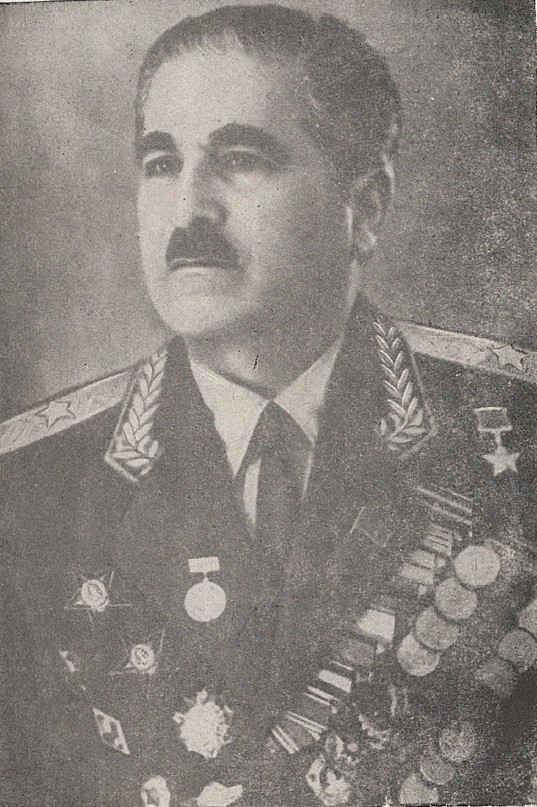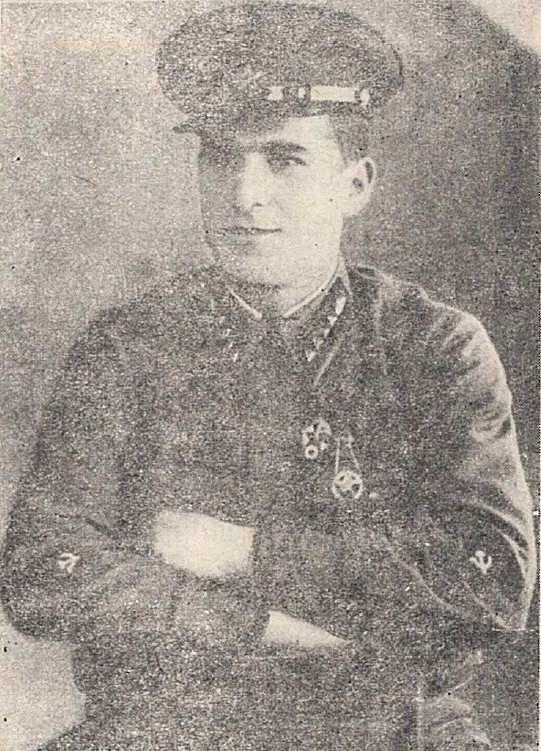The hero of the Soviet Union, a native of Shusha: Khalil Mammadov
Major-General Khalil Mammad oghlu Mammadov was born on May 5, 1916 in the city of Shusha in the family of a hatmaker.
[Heroes of the Soviet Union. A short biographical dictionary. 2. 1988, p. 31]
[F.Ganizade. A man lives among us. 1976, pp. 7;10]

Soon Khalil’s family moved to Ashgabat (Turkmenistan). Here, he entered high school. After graduating from the industrial college in 1937, Khalil Mammadov worked as an engineer at a locomotive plant (in some sources, a car repair plant) in Kyzyl-Arvat (now c. of Serdar. Turkmenistan).
[A.A.Huseynov. Azerbaijan 1941-1945. Heroes of the Soviet Union. 2017, p. 204]
[Heroes of the Soviet Union. A short biographical dictionary. 2. 1988, p. 31]
[F.Ganizade. A man lives among us. 1976, p. 9]
In 1939, Khalil Mammadov was called up for the Soviet army, and in 1940, after graduating from the tank battalion regimental school, he was appointed a tank commander.
[Azerbaijani Soviet Encyclopedia.vol. VI 1982, p. 503]
[Heroes of the Soviet Union. A short biographical dictionary. 2. 1988, p. 31]
[A.A.Huseynov. Azerbaijan 1941-1945. Heroes of the Soviet Union. 2017, p. 204]
[F.Ganizade. A man lives among us. 1976, p. 9]
During the Great Patriotic War (1941-1945) Khalil Mammadov commanded a tank platoon (1942), a company (1943) and then a battalion (January 1944). In August 1941, he participated in the Anglo-Soviet invasion of Iran. Khalil Mammadov took part in the battles for the North Caucasus, Crimea, Donbass, Ukraine, Moldova, Romania, Hungary and Austria.
[A.A.Huseynov. Azerbaijan 1941-1945. Heroes of the Soviet Union. 2017, p. 204;206;208]
[F.Ganizade. A man lives among us 1976, p. 13;25;66]
Around in 1942, Khalil Mammadov was wounded in one of the battles, but despite this he refused to go to the hospital and continued to fight. In the book of 1976 by F.Ganizade “A man lives among us” there is noted the following:
“It was getting dark. It was necessary to occupy enemy positions before the dark fell. Khalil’s tank was among the first to break into the enemy’s location. Even before the start of the counterattack, Khalil decided to replace the driver who was wounded in the previous battle. And now he was skillfully maneuvering, allowing the crew to conduct targeted fire. Not far (from the trenches) an enemy shell exploded. A huge fragment, hitting the tank, tilted the caterpillar’s track. The steel machine was spinning on the spot. Under a hail of bullets, Khalil and the shooter got out of the tank and began repairing the caterpillar. The warriors did almost the impossible – in a matter of minutes they fixed the track of the caterpillar. But when Khalil was descending through the hatch into the tank, a shell fragment hit him in the nose bridge (the upper part of the nose adjacent to the forehead). Hastily bandaging his head, the commander continued the fight until our infantry occupied the enemy trenches.“
[F.Ganizade. A man lives among us. 1976, pp.16-17]
[A.A.Huseynov. Azerbaijan 1941-1945. Heroes of the Soviet Union. 2017, p. 205]

In 1944, in the battles on the territory of Romania, thanks to the brilliant command of Khalil Mammadov, the German troops suffered a major defeat. In A.A.Huseynov’s book “Azerbaijan 1941-1945. Heroes of the Soviet Union” of 2017, there is noted:
“On August 21, 1944, before Captain Mammadov and his tank battalion there was set the combat task of capturing the city of Târgu Frumos. However, a frontal attack on a heavily fortified area met fire resistance. In addition, there were a number of anti-tank obstacles. Considering the situation, the battalion commander turned the battalion to the southeast and broke through the enemy defenses where the Germans least expected the appearance of Soviet tanks. Mammadov’s battalion, sweeping away the detachments of the barrier, broke into the city and seized it on the move. On August 23, Mammadov’s tanks reached the Seret River. The river crossing was blown up by retreating German units. Despite this, without waiting for its restoration, the battalion tanks, following the commander (crossing, moving along the bottom of the river in a shallow place), forced and, pursuing the retreating enemy, rushed to the city of Roman. The Nazis, seeking to detain the battalion, put tanks in the way of its movement, but Khalil Mammadov, skilfully bypassing the barrier, broke into the city and completely destroyed the defending garrison in a short battle. Not stopping there and continuing to fulfill the task assigned to the battalion, Khalil Mammadov captured the city of Bakau, Adjud Noua and the Onesti station. In total, during this period of time, the battalion under the command of Mammadov destroyed four tanks, two self-propelled guns, 64 artillery pieces, 191 vehicles and 1,375 enemy soldiers and officers. Three railway echelons with military cargo, 350 vehicles, and 22 guns were captured as trophies. 4,000 soldiers and officers were captured.“
On March 24, 1945, Khalil Mammadov was awarded the title of Hero of the Soviet Union for his skilful leadership of the battalion during the defeat of the German defense hub in the city of Mercury Chiukului (now the city of Merkurea-Chuk or Mierkurea-Sibiului in Romania) and for his personal bravery in battles. In 1946, Mammadov in the rank of major was sent to the reserve.
[Golden stars of Azerbaijan.1975, p. 204]
[Heroes of the Soviet Union. A short biographical dictionary. 2. 1988, p. 31]
[A.A.Huseynov. Azerbaijan 1941-1945. Heroes of the Soviet Union. 2017, pp. 211-212]
[F.Ganizade. A man lives among us. 1976, pp.58-60]
In 1955, Khalil Mammadov graduated from the Higher Party School under the Central Committee of the CC CPSU.
[Heroes of the Soviet Union. A short biographical dictionary. 2. 1988, p. 31]
[Azerbaijani Soviet Encyclopedia. vol. VI 1982, p. 503]
In 1957-1960 Khalil Mammadov held the post of Deputy Minister of Internal Affairs and in 1960-1965 (1962-1964) the post of Minister of Internal Affairs of the Azerbaijan SSR.
[Azerbaijani Soviet Encyclopedia.vol. VI 1982, p. 503]
[Deputies of the Supreme Soviet of the Azerbaijan SSR. 1973, p. 231]
Khalil Mammadov was elected deputy of the Supreme Soviet of the Azerbaijan SSR (now the National Assembly of the Republic of Azerbaijan). He also worked as the head of the department of the bodies of the Council of Ministers of the Azerbaijan SSR.
[Azerbaijani Soviet Encyclopedia.vol. VI 1982, p. 503]
[“Bakinskiy Rabochiy” newspaper № 46 (21471) 02/23/1989., p. 3]
[Golden stars of Azerbaijan.1975, p. 204]
1971-1974 Khalil Mammadov was the chairman of the Committee on Physical Culture and Sports of the Azerbaijan SSR.
[Azerbaijani Soviet Encyclopedia. vol. VI 1982, p. 503]
[“Bakinskiy Rabochiy” newspaper № 46 (21471) 02/23/1989., p. 3]
Khalil Mammadov was awarded medals “For the Capture of Berlin”, “For the Capture of Vienna”, “For the Victory over Germany”; Orders of the Red Star (twice), Alexander Nevsky, Lenin, the Patriotic War of the 1st degree and the Red Banner of Labor. A vessel of the Ministry of the Navy of the USSR was named after him.
[A.A.Huseynov. Azerbaijan 1941-1945. Heroes of the Soviet Union. 2017, p. 204]
[Heroes of the Soviet Union. A short biographical dictionary. 2. 1988, p. 31]
[Azerbaijani Soviet Encyclopedia.vol. VI 1982, p. 503]
Khalil Mammadov died after a long illness on February 21, 1989. He was buried at the II Alley of Honorable Burial in Baku.
[“Bakinskiy Rabochiy” newspaper №.46 (21471) 02/23/1989., p. 3]